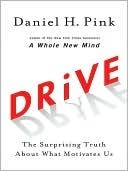More on this book
Community
Kindle Notes & Highlights
the starting point for any discussion of motivation in the workplace is a simple fact of life: People have to earn a living. Salary, contract payments, some benefits, a few perks are what I call “baseline rewards.” If someone’s baseline rewards aren’t adequate or equitable, her focus will be on the unfairness of her situation and the anxiety of her circumstance. You’ll get neither the predictability of extrinsic motivation nor the weirdness of intrinsic motivation. You’ll get very little motivation at all.
The best use of money as a motivator is to pay people enough to take the issue of money off the table.
extrinsic rewards can be effective for algorithmic tasks—those that depend on following an existing formula to its logical conclusion. But for more right-brain undertakings—those that demand flexible problem-solving, inventiveness, or conceptual understanding—contingent rewards can be dangerous. Rewarded subjects often have a harder time seeing the periphery and crafting original solutions.
For artists, scientists, inventors, schoolchildren, and the rest of us, intrinsic motivation—the drive to do something because it is interesting, challenging, and absorbing—is essential for high levels of creativity. But the “if-then” motivators that are the staple of most businesses often stifle, rather than stir, creative thinking.
Goals that people set for themselves and that are devoted to attaining mastery are usually healthy. But goals imposed by others—sales targets, quarterly returns, standardized test scores, and so on—can sometimes have dangerous side effects.
The problem with making an extrinsic reward the only destination that matters is that some people will choose the quickest route there, even if it means taking the low road.
When the reward is the activity itself—deepening learning, delighting customers, doing one’s best—there are no shortcuts. The only route to the destination is the high road. In some sense, it’s impossible to act unethically because the person who’s disadvantaged isn’t a competitor but yourself.
“Goals may cause systematic problems for organizations due to narrowed focus, unethical behavior, increased risk taking, decreased cooperation, and decreased intrinsic motivation. Use care when applying goals in your organization.”
Any extrinsic reward should be unexpected and offered only after the task is complete.
Praise and positive feedback are much less corrosive than cash and trophies.
Human beings have an innate inner drive to be autonomous, self-determined, and connected to one another. And when that drive is liberated, people achieve more and live richer lives.
Type I behavior promotes greater physical and mental well-being.
Ultimately, Type I behavior depends on three nutrients: autonomy, mastery, and purpose. Type I behavior is self-directed. It is devoted to becoming better and better at something that matters. And it connects that quest for excellence to a larger purpose.
Researchers have found a link between autonomy and overall well-being


